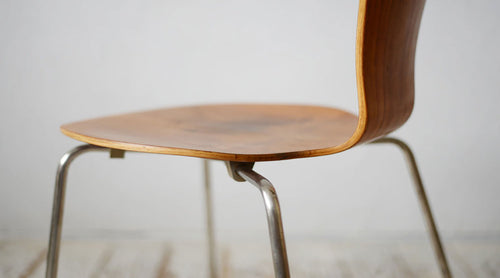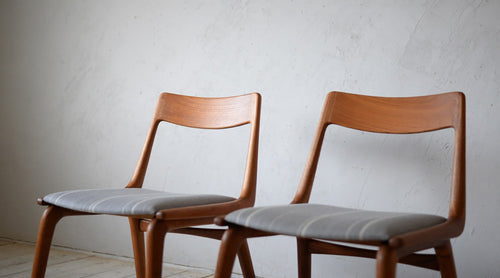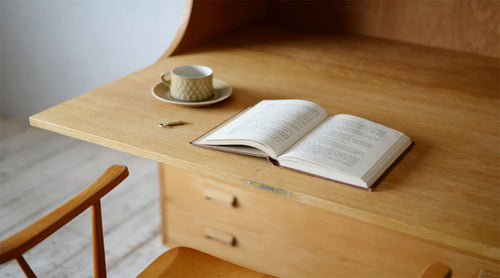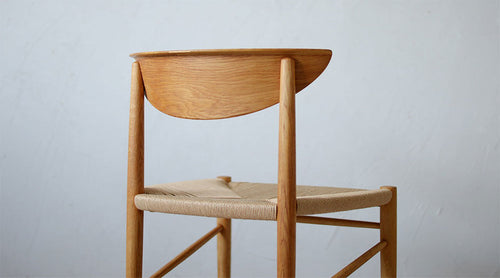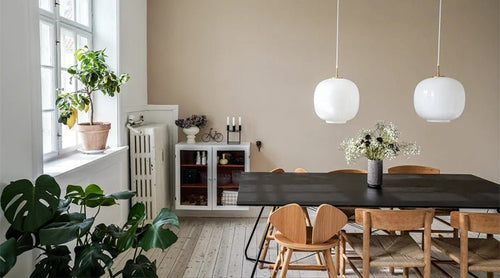Hello, this is Fukuda from Greenwich Daikanyama. This time, our repair staff will talk about the appeal of vintage furniture that just arrived in June from a craftsman's perspective. Both products are niche and contain a lot of content, so please take a look.

Poul.M.Volther 's "J48" is a simple and functional product.
The frame is made of oak and features a back made of three top rails. The rounded, gentle curves of the chair gently wrap around your body, giving it a sense of stability. The top rails are carefully repaired by removing them one by one, sanding them, and applying an oil finish.
This chair requires the skill to sand the top board and frame while leaving the curves intact, and then re-glue them along the curve without any gaps.
*For more information on Greenwich vintage repairs, see this blog


The oak used in vintage chairs is mostly European oak, which is made from particularly high-quality wood compared to modern oak, and when oiled it takes on a deep amber color. Its appearance changes drastically with age, and it has a nice texture, so it's one of my personal favorites. The spine is a point worth noting, as it shows the attention to design that is unique to vintage items.
I think it would be interesting to compare the differences with the current product.

The upholstery is made by danishartweaving, a Danish company that specializes in furniture fabrics with a focus on materials and patterns.
This time, it has been reupholstered in 100% wool Grande green. The natural color creates a calm atmosphere.

Wool absorbs the moisture released by the body and releases it into the air, so you won't feel damp even in the summer. Also, when it gets wet, it naturally generates heat and becomes warm. Wool's characteristics are its heat retention, moisture absorption and release, and elasticity. It is warm in winter and cool in summer, making it the perfect chair for creating a comfortable space for the coming seasons. You won't get tired even if you sit on it for a long time, so I think it will be a chair that you can sit on and enjoy doing what you like in your favorite place.
Repair staff member Kobayashi

A linear design typical of Mogensen.
The beautiful curves of the backrest have been designed with comfort in mind.
It was developed and distributed to hospitals and nursing homes across Denmark.
Starting in the 1960s, a large number of prime facilities (equivalent to special nursing homes in Japan), which were derived from poorhouses and nursing homes, were built, and in the 1970s, the number of facilities increased and they became larger in size.
Denmark's social welfare policy has been developed based on the idea of normalization.
Normalization is a concept proposed by Danish scientist Bank Mikkelsen in the 1960s as a protest against the institutional policies and various special measures that had been implemented in the name of welfare for people with disabilities. It is often explained as "a normal society is one in which people with disabilities can live equally and as a matter of course with able-bodied people, rather than excluding them," or "to the greatest extent possible, people with disabilities should be guaranteed the right to lead a normal life that all people have."
Normalization was a movement that appealed to society for the right of disabled people and able-bodied people to live together in society without any distinction between them, and it is said that Denmark and other Nordic countries supported this movement by strengthening their home-centered welfare policies based on local government. When we consider the historical background of the time, and the fact that furniture manufacturers and designers designed in line with this movement and philosophy, the words "design that is typical of Mogensen" make us think even more when we see the actual products.
It is easy to imagine that products made for nursing facilities will need a considerable number of units, and that there will be many production aspects that are necessary apart from durability, such as the need to replace parts.
Therefore, this product can be roughly divided into three parts: the back frame, seat frame, and frame, with the parts fastened with screws, the parts assembled with dowels, and the parts joined with mortise and tenon joints.
The cushions are also separate and can be removed by hooking them onto metal fittings on the frame with string or leather to prevent them from moving.
The parts that need strength, the ease of production, and the ability to be replaced are all well thought out.
The linear design, functionality, simplicity and lack of clumsiness make this a very Mogensen-like design.
The intentions and ideas of designers and manufacturers that keep up with the times
I think that when you look at the actual product against the background of a well-thought-out design, you can feel the message conveyed by the shape even more. If you are interested, we are exhibiting it in Daikanyama, so please come and see it for yourself.
Mogensen's design
In Denmark, in order to take concrete measures to quickly improve the treatment of the elderly, the Committee on Elderly Policy was established in 1979, and a new direction was set with a focus on separating residential and care functions. The report of this committee set out the "Three Principles for the Elderly" (1982), which should serve as the basis for future elderly policies, and decided to prohibit the construction of new prime housing and shelter housing, thus setting a new direction for Denmark.
Three principles for the elderly
○ Live a life that is continuous and not disconnected from the life you have lived up until now (principle regarding the continuity of life)
○ Respect the self-determination of the elderly and support it (principle of self-determination)
○ Supporting independence by focusing on existing abilities (principle regarding activation of remaining abilities)
The textiles were made using fabrics designed by Lisa Ahlmann at the time.
Repair staff: Yamaguchi
ーーーーーーーーーーーーーーーーーーーーーーーーーーーーーーーーーーーーーーーー
What did you think?
We asked the staff who actually repaired the items to talk about the appeal of the vintage items they received.
At Greenwich, we receive vintage furniture every month, and the Daikanyama staff and repair craftsmen hold meetings to select the vintage furniture to be delivered (selecting upholstery and repair methods, etc.).
Vintage furniture will arrive next week on the 12th (Wednesday). You can see it at our Daikanyama store from the 14th (Friday).
We look forward to your visit!
Greenwich Daikanyama Fukuda













